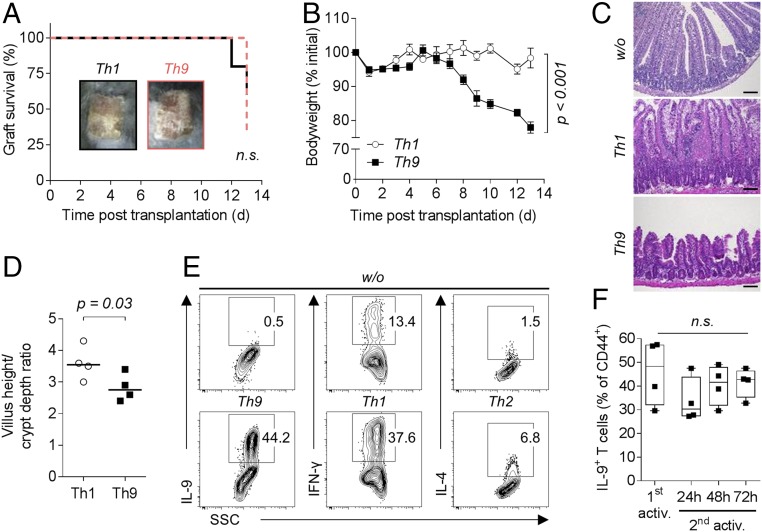Fig. 1.
Transfer of Th9 cells into B cell- and T cell-deficient Rag1−/− mice causes graft rejection, weight loss, and intestinal inflammation. (A–D) C57BL/6 Rag1−/− mice received 1 or 2 × 105 activated (CD44+) T cells sorted from in vitro differentiated alloreactive C57BL/6 Th1 (n = 4–5) or Th9 (n = 4–7) cultures and a BALB/c skin graft on the following day. (A) Survival of BALB/c donor skin. A Log-rank (Mantel–Cox) test was applied. (B) Body weight of mice depicted as mean ± SEM. P value of the interaction term (group with time) was calculated using an ANOVA type III test after fitting a linear mixed-effect model to the body weight data. (C) Representative hematoxylin and eosin stained ileum sections collected on day 12 (w/o) or 13 (Th1, Th9) post skin transplantation. (Scale bar: 100 µm.) (D) Villus height-to-crypt depth ratio in ileal mucosa with median value. For statistical analysis, a one-tailed Mann–Whitney test was applied. (E) Staining of in vitro differentiated alloreactive (CD44+) BALB/c T cells for intracellular expression of signature cytokines. Cells were cultured for 3 d in the absence (w/o) or presence of Th9, Th1, or Th2 polarizing cytokines. (F) Intracellular staining for IL-9 in activated (1st activ.) and (with allogeneic dendritic cells) reactivated (2nd activ.) in vitro differentiated alloreactive C57BL/6 Th9 cells (n = 4). Statistical analysis by Kruskal–Wallis test. n.s., not significant (P > 0.05).

